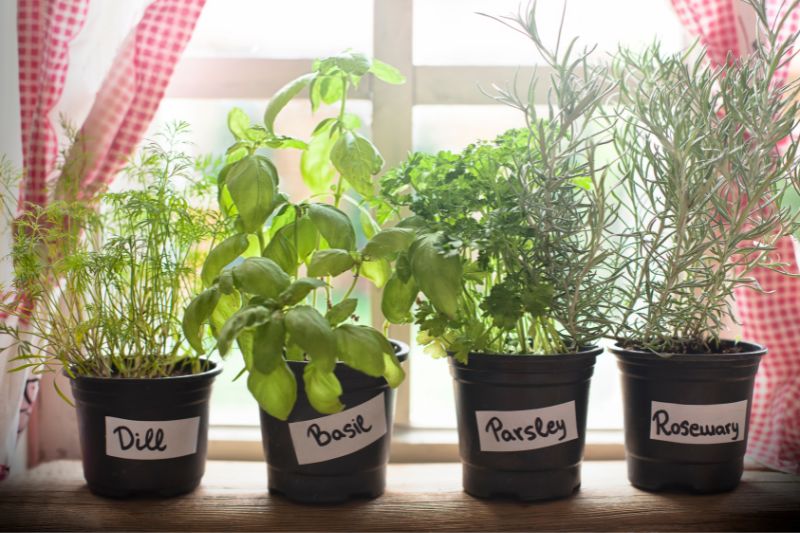While temperature drops and the daylight shortens during winter, many people resign themselves to a season without fresh herbs. However, you can still enjoy a bountiful harvest right in the comfort of your home? Yes, growing herbs indoors during the winter is not just possible but also fun and rewarding.
Now, let’s see what it takes to do so!
Table of Contents
Challenges of Growing Herbs Indoors in Winter
Growing herbs indoors during the winter comes with a unique set of challenges, but with proper care and attention, these can be easily managed.
1. Reduced Natural Light
Winter days are shorter, and sunlight is often less intense, leading to insufficient light for plant growth.
Solution: Position your herbs near south-facing windows for maximum natural light exposure. If that’s not possible, supplement with artificial grow lights tailored for plant growth.
2. Dry Indoor Air
Indoor heating systems can create a dry environment, not ideal for most herbs.
Solution: Increase humidity around your plants by placing a tray of water near them, using a room humidifier, or misting the plants lightly with water.
3. Temperature Fluctuations
Rapid changes in temperature can stress plants, especially when moving them from a warm indoor setting to a cooler one or vice versa.
Solution: Try to keep your herbs in a consistent temperature range as specified for each type. Avoid placing plants near heating vents, radiators, or drafty windows.
4. Pest Risks
Indoor plants can become more susceptible to pests like spider mites, aphids, and whiteflies.
Solution: Regularly check your plants for signs of pests and treat as needed using organic methods like neem oil or insecticidal soap.
What Are The Best Herbs to Grow Indoors Over the Winter?

1. Basil
- Light: Full sun, at least 6-8 hours a day
- Water: When the topsoil is dry
- Temperature: 65-70°F (18-21°C)
2. Chives
- Light: Full sun to partial shade
- Water: Keep soil moist but not waterlogged
- Temperature: 60-70°F (15-21°C)
3. Mint
- Light: Partial shade to full sun
- Water: When the topsoil is dry
- Temperature: 60-75°F (15-24°C)
4. Oregano
- Light: Full sun
- Water: When the topsoil is dry
- Temperature: 65-70°F (18-21°C)
5. Parsley
- Light: Full sun to partial shade
- Water: Keep soil moist but not soggy
- Temperature: 60-70°F (15-21°C)
6. Rosemary
- Light: Full sun
- Water: When the soil is almost dry
- Temperature: 60-70°F (15-21°C)
7. Thyme
- Light: Full sun
- Water: When the topsoil is dry
- Temperature: 60-70°F (15-21°C)
8. Cilantro
- Light: Full sun to partial shade
- Water: When the topsoil is dry
- Temperature: 55-70°F (12-21°C)
9. Sage
- Light: Full sun
- Water: When the soil is almost dry
- Temperature: 60-70°F (15-21°C)
» Check our our guide on how to grow sage indoors.
10. Dill
- Light: Full sun
- Water: When the topsoil is dry
- Temperature: 60-70°F (15-21°C)
Tips for Successful Indoor Herb Growing
- Choose the Right Location
As mentioned above, it’s ideal to place your herbs near a sunny window where they can get at least 6-8 hours of light. If natural light is insufficient, consider using artificial grow lights.
- Use Quality Soil
Soil quality can make or break your indoor herb garden. A well-draining, nutrient-rich organic potting mix is essential for healthy root development and optimal nutrient absorption.
Avoid using garden soil or heavily compacted soil, as these can hinder drainage and may contain pests or diseases. Many garden centers offer specialized potting mixes for herbs, which can take the guesswork out of choosing the right soil.
- Watering Guidelines
Proper watering is essential for herbs that are growing indoors, as both overwatering and underwatering can lead to poor plant health. Check the moisture level of the soil regularly, ideally by feeling the top inch with your finger.
If it feels dry, it’s time to water. A watering schedule may vary depending on the specific needs of each herb, so take time to understand the water requirements of the herbs you choose.
- Proper Drainage
Good drainage is also important. Always choose pots with drainage holes and consider placing a saucer underneath to catch excess water. This prevents water from pooling at the bottom of the pot, which can cause root rot.
If you’re using a decorative pot without drainage holes, you can place a layer of rocks or gravel at the bottom to help with drainage, but a pot with holes is usually a better option.
- Humidity and Temperature
Indoor heating systems can lead to dry air conditions that are less than ideal for most herbs. To solve this, you can place a tray of water near your plants to increase humidity.
You can also use a room humidifier to maintain a more consistent moisture level. Keeping the room temperature stable is also important, especially during winter when fluctuations are more common.
- Pruning and Harvesting
Regular pruning is beneficial for most herbs, encouraging a bushier growth and greater yield. Use clean, sharp scissors or pruning shears to remove the top leaves, taking care not to cut more than one-third of the plant at a time.
Harvesting can usually begin when the plant has enough foliage to maintain growth; this is typically when they are 6-8 inches tall.
- Pest Control
Watch for common pests like aphids and spider mites and treat with organic solutions like neem oil or insecticidal soap.
Conclusion
Growing herbs indoors over the winter is not only doable but also rewarding. By selecting the right herbs and providing them with proper care, you can enjoy fresh flavors and greenery throughout the colder months.
And if you’re looking to save your existing potted herbs, make sure to check our guide on how to bring them indoors over the winter.






No Comments